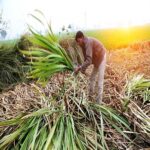Bengaluru, Karnataka : With reservoirs across Karnataka already 80% full and water releases underway, officials are optimistic about a strong agricultural season this year. Pre-monsoon showers have helped advance the kharif sowing cycle, with nearly 73% of the targeted area already sown, ahead of last year’s pace, reports The Times of India.
As of July 26, the state’s major reservoirs collectively held 712.5 tmcft of water, an increase from 679 tmcft at the same time last year, according to data from the Karnataka State Natural Disaster Monitoring Centre (KSNDMC).
The stored water spans the state’s three main river basins — the Cauvery with 111.2 tmcft (up from 109.9 tmcft), the Krishna with 349.3 tmcft (up from 341.3 tmcft), and the Hydel basin with 228.8 tmcft (a significant rise from 209.9 tmcft). Vani Vilas Sagar has also seen good inflows. Karnataka’s 14 major dams together have a total capacity of 895.6 tmcft.
Minor Irrigation Minister Boseraju NS said the season has brought good news for farmers. “With good rainfall this year and the reservoirs nearly full, agriculture will benefit even more. The irrigation department is already diverting water as per routine planning, ensuring good crop yield,” he said.
He added, “Water and power are two essentials for farmers — if both are available, they face no issues. But if rains fail, prices rise and farmers suffer. Fortunately, this year, things are looking positive.”
According to an agriculture department official, sowing so far has crossed 72%, compared to 69% during the same period last year. “Early water release and timely rain in June have benefited rain-fed and horticulture areas. The paddy belts in the Tungabhadra command area, and Krishna and Cauvery basins, are expected to perform better than last year,” the official said.
However, farmer leader Chukki Nanjundaswamy expressed concern over pest-related losses. “Nearly 70,000 hectares of maize were lost this year due to fall armyworm attacks and fungal infections — a result of last year’s early rains. Only 40% of farmland is canal irrigated; the rest depends on rainfall. New pests and diseases are emerging, but no comprehensive study has been done to address them. Farmers are left to deal with the impact on their own,” she said.
Ramesh Chandra Lahoti, past president of the Federation of Karnataka Chambers of Commerce and Industry (FKCCI) and the Bangalore Wholesale Pulses & Food Grains Merchants’ Association, said moderate rainfall would be key in the coming weeks. “Pulses like green gram, tur, and chana have already been sown, followed by paddy. If rainfall continues at a moderate pace without causing flooding, it will benefit farmers and consumers alike, ensuring price stability,” he said.
As of July 18, sowing had been completed on 57.8 lakh hectares out of a target of 82.5 lakh hectares. Early sowing exceeded expectations, reaching 107% of the target for the early kharif period.
Rainfall across the state has remained close to normal, with 349 mm recorded so far compared to the season’s average of 356 mm. Reservoir inflows remain strong — with the Hydel and Krishna basins each receiving 1.1 lakh cusecs, and the Cauvery basin recording an inflow of 51,184 cusecs.

















